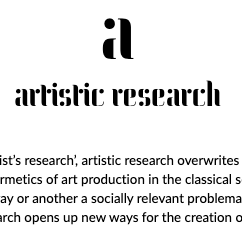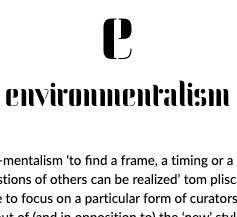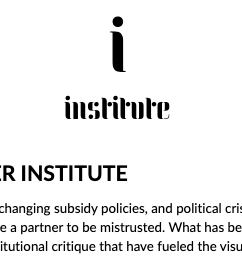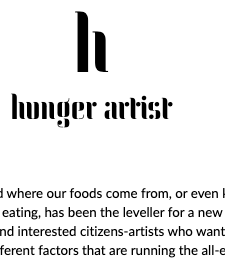artistic research

artistic research
“Other than the ‘artist’s research’, artistic research overwrites the isolation and the hermetics of art production in the classical sense, in addressing in one way or another a socially relevant problematics. This kind of artistic research opens up new ways for the creation of a ‘generous cultural memory’.”
1. ‘artistic research’
To clarify what kind of research a.pass sustains, a minimum of conceptual transparency is needed. When we combine the terms ‘research’ and ‘artistic’, most of the time we are dealing with a research ON the arts (art history, musicology, theatre sciences, aspects of cultural sociology, esthetics etc…) or a research IN the arts (a research that is part of a (regular) artistic practice). What we in a.pass consider as artistic research – a term that is often understood in reference to the Anglo-saxon models for practice-based research – often is the result of a research In the arts, but cannot be reduced to it. a.pass doesn’t want to limit its range of research to the ‘artist research’ full stop: the necessarily research-oriented attitude that accompanies any kind of serious artistic endeavour, which does not necessarily have any link to the communication and valorization of research results as it is demanded in an academic context. ‘Research’, as it is understood in the artistic practice, is an evident part of this practice which allows for a result-oriented reflection on the work, or in other words: a research oriented towards the production of the art work as a product, as a repertory and/or as an oeuvre.
In the a.pass environment, and in a playful questioning of the ‘academic’ research mind-set, this individual artist is not the sole focus of attention, or at least not in the sense that we perceive our researchers as artists tout court. An artist research has an inherent logic and validity, but does not necessarily have a need to be communicative to an outside community in any other form than through the production of art works. a.pass reflects on a research in the arts that is more than a report – in the art work itself or in the accompanying dissertation – of the individual research of an artist. What we consider an artistic research project is rather:
‘a new practice in the arts, which differs from the individual artist practice, as well as from the art historical or scientific research practice. One researches not only the art through the art works, but the functioning of art and the breadth of the art practice by way of interdisciplinary interventions in the (semi-)public, societal domain. Artistic research is an interdisciplinary concentration around a ‘binding’ problem that catches the attention of a pluriform group of participants.’ (Jouke Kleerebeezem, De Witte Raaf)
This means that a question in the research of a.pass is always situated in a broader context than that of the sole artist: a lot of the questions that are posed in a.pass generate collective discussions and critique, find their way (partly) into other researches or attempt temporary coalitions in the defining and/or broadening up of a certain problematics. Important in this environment is the shared reflection concerning ways of working, diverse understandings of artistic research, the development of (post-disciplinary) perspectives and the experimentation with methodologies and strategies. The work of the artistic researcher does not coincide with the work of the artist in the sense that it is self-conscious, and explicitly communicates and circulates this self-reflection within a wider group of stakeholders.
In other words, the emphasis in this kind of research is not so much on the conception and production of an art work – although this undeniably and unavoidably is part of the whole of the research – but rather on a questioning that puts the individual art practice and even the recognizable mono-discipline in a wider perspective. This kind of research originates from and builds on the demands and problematics of a shared debate, and can be approached by different specialist researchers, each addressing the question out of his own domain. The length, the quality criteria, the form, the communication strategies and the required ‘relevance’ of the research – and thus also the understanding of the requirements of the PhD-project that might eventually result out from it – are thus in principle dependent on the context and have to be negotiated on a project base between the researcher and the institution(s) involved. It is in this case very important to recognize a wider ‘public’, the potential users of this research, as a partner in this trajectory, and to develop the appropriate communication channels to make this participation possible.
2. “A new art terrain escapes in the best case scenario the doom of splendid isolation, WITHOUT losing the special and meaningful privilege of unusefulness that characterizes the symbolic practice.” (Jouke Kleerebeezem)
Other than the ‘artist’s research’, artistic research overwrites the isolation and the hermetics of art production in the classical sense, in addressing in one way or another a socially relevant problematics. This kind of artistic research opens up new ways for the creation of a ‘generous cultural memory’. But at the same time the societal relevance of this research cannot coincide with its utilitarian value, since the direct impact of the research practice and reflection necessarily develops through artistic, affective gestures of experimentation and communication that resonate with, but never answer to, the concrete questions posed within the societal fabric. This kind of research thus will only influence the daily social, political, economic or scientific reality by a detour, through the unsettling of its self-reflection and imagination(s). This independent position, free from any preconditioned political preconceptions, economic value or socially determined relevance is a necessary and undeniable characteristic of this research practice.
More than a pragmatic laboratory for the production of answers on societal questions, the research lab that is a.pass offers the possibility to construct an ‘general intellect’: a way of working wherein researchers collectively give form to diverse practices to produce and articulate knowledge in an open, shared research environment.
3. ‘Old cultural dichotomies have come to collapse: those of knowledge and imagination, thinking and doing, language and image, truth and illusion, theory and practice, object and process.” (Camiel Van Winkel)
In a.pass the relevance of the research is measured by the degree in which researchers, out of their different backgrounds and knowledge horizons, manage to formulate innovative perspectives on potential knowledge production, as well as on the development of tools to share and experiment this knowledge on the public scene. It is clear that the development of this kind of research environment also resonates with other institutions for art education on an (inter)national scale. Artistic research in a.pass can be seen as a third way, wedged in between the artistic practice as such and the more academic understanding of knowledge production. Different from the artistic practice the research is not limited to the individual trajectory, the personal questioning and aesthetics of the artist. But at the same time the art practice does take a central role in the development of new perspectives and methodologies, a way of working that relates to, but doesn’t coincide with, and even explicitly questions an academic AND an artistic framework. Artistic research in a.pass is not limited to the development of arts-practice-related knowledge, but also involves the creation and testing of formats, methodologies, communication strategies and shared practices, ‘tools for collaboration and communication’, that broaden up the understanding of artistic research from an art work with paper validation form to a more critical investigation into the statute, the circulation and the valuation of divergent forms of knowledge.





